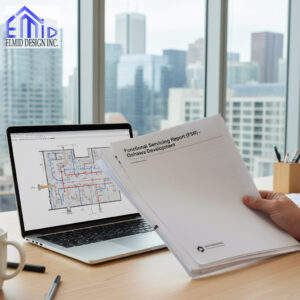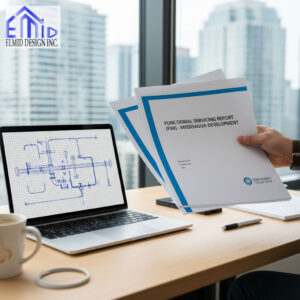A functional servicing report in Ajax is a detailed technical document that supports land development by confirming that proposed buildings and infrastructure can be properly serviced by municipal systems. Moreover, developers, planners, and engineers depend on it to verify that water, sanitary, and storm systems meet the standards of the Town of Ajax and the Province of Ontario. In addition, understanding how to prepare and interpret this report can save valuable time and prevent costly redesigns during the approval process. Furthermore, it ensures that every project remains compliant with all local and provincial regulations. As a result, this guide explains each stage of the functional servicing report process in Ajax and shows how experts at Elmid Design Inc help ensure that all projects are efficient, accurate, and fully approved.
Key Takeaways
The functional servicing report is mandatory for most developments in Ajax.
It confirms capacity for water, sanitary, and stormwater systems.
Elmid Design Inc prepares detailed, PEO-authorized reports meeting municipal standards.
Comprehensive FSRs protect both developers and the community from service failures.
Understanding What a Functional Servicing Report Is
A functional servicing report (FSR) is a detailed engineering study showing how a new development connects to existing municipal infrastructure. It evaluates the impact on water, sanitary, and storm systems. The Town of Ajax requires it for subdivision, site plan, or rezoning applications. The FSR demonstrates that the development can operate safely within the available service capacities. This document also identifies upgrades or new systems required to maintain proper service levels. By addressing these issues early, developers avoid conflicts with municipal engineering requirements and streamline project approvals.
Why Functional Servicing Reports Matter in Ajax
In Ajax, every new project must align with local planning policies and infrastructure capacity. The FSR ensures new developments will not overwhelm municipal systems or cause flooding, water shortages, or sewage backups. Ajax’s planning department uses the report to assess technical feasibility before granting final approval. The town’s strong focus on infrastructure management makes accurate servicing studies essential. A precise functional servicing report also supports responsible growth and sustainable water resource management within the community.
The Role of Elmid Design Inc in Functional Servicing Reports
Elmid Design Inc, a professional engineering firm authorized by Professional Engineers Ontario, specializes in preparing functional servicing reports for Ajax and across the Greater Toronto Area. Moreover, their extensive expertise ensures that every section of each report fully meets municipal technical standards and complies with provincial design manuals. In addition, the firm’s engineers carefully evaluate water, sanitary, and stormwater systems through advanced modeling and precise field data. As a result, they provide accurate and reliable solutions tailored to local conditions. Furthermore, their deep understanding of Ajax’s municipal infrastructure and regulatory expectations allows clients to secure approvals faster while avoiding costly delays. Ultimately, this strong technical authority builds long-term trust with developers and reinforces full compliance with PEO standards.
Municipal and Provincial Standards Governing FSRs
Functional servicing reports in Ajax follow strict guidelines from both the Town of Ajax and the Province of Ontario. The content must satisfy requirements set by the municipal engineering department, regional water authorities, and the Ministry of the Environment, Conservation and Parks. The reports follow best practices outlined in provincial design manuals for stormwater and sanitary systems. Ajax’s standards require data consistency, reliable modeling, and transparent analysis. Meeting these criteria ensures the municipality can safely integrate each new development into its existing infrastructure network.
Core Components of a Functional Servicing Report
An FSR in Ajax typically includes several key sections. It begins with a site description detailing location, size, and existing conditions. The next part covers water supply, analyzing pressure zones, fire flow capacity, and connection points. The sanitary section reviews available capacity, flow projections, and system connections. The stormwater section evaluates drainage patterns, catchment areas, and on-site management systems such as infiltration ponds or detention facilities. The report concludes with grading, utility coordination, and recommendations for future maintenance. Every section must include calculations, supporting maps, and references to municipal design standards.
Site Description and Existing Conditions
This section provides an overview of the property and its surroundings. It defines property boundaries, existing land use, and proximity to municipal systems. Understanding topography and surface drainage patterns is vital to determine feasible connections for stormwater, water, and sanitary systems. Engineers must also review existing infrastructure drawings from the Town of Ajax and verify conditions through field visits. The site description sets the foundation for accurate capacity assessment and design decisions.
Water Servicing and Fire Flow Capacity
A key part of the functional servicing report is water supply analysis. Engineers calculate daily and peak water demands based on land use and population density. They review nearby water mains, pressure zones, and fire flow data to confirm adequate supply for domestic and firefighting needs. Hydraulic modeling may be required to confirm that pressure levels meet municipal standards. If existing systems cannot meet projected demands, the report proposes system upgrades or new watermain extensions. Proper fire flow analysis ensures the development complies with Ontario Building Code and municipal fire protection requirements.
Sanitary Servicing Design
The sanitary system section estimates sewage generation based on development type and size. It identifies connection points to existing sanitary sewers and checks available capacity within municipal mains. Flow calculations include peak factors to ensure the system can handle both average and maximum loads. If constraints are found, the functional servicing report in Ajax outlines solutions such as larger pipes, on-site storage, or off-peak pumping. Detailed sanitary analysis prevents surcharging, backups, and environmental risks while ensuring compliance with Ajax’s infrastructure standards.
Stormwater Management and Drainage
Stormwater management is one of the most critical parts of any functional servicing report. In Ajax, where urbanization increases runoff, proper drainage design protects both private property and public systems. Engineers model existing and proposed drainage patterns, assess overland flow routes, and size storm sewers or retention ponds to control peak flows. The design often includes low-impact development measures like permeable pavements, bioswales, and infiltration trenches to improve water quality. The FSR must demonstrate that post-development runoff rates do not exceed pre-development levels, ensuring compliance with municipal stormwater policies.
Common Challenges in Ajax Developments
Ajax developments often face challenges related to limited infrastructure capacity or aging systems. In some areas, existing storm or sanitary networks are near their design limits. Coordinating with multiple departments can also delay approvals if information is incomplete. A functional servicing report prepared by experienced engineers helps identify these issues early and present realistic solutions. Proactive design and communication prevent conflicts with municipal review staff and keep development schedules on track.
Process of Preparing a Functional Servicing Report in Ajax
The process of preparing a functional servicing report in Ajax begins with a pre-consultation meeting between the developer, municipal planners, and engineers. This step identifies which studies and design standards apply to the project. Engineers from Elmid Design Inc then collect data on topography, existing services, and property boundaries. They review municipal drawings and identify connection points for water, sanitary, and storm systems. Once the data is complete, the design team performs hydraulic and hydrologic calculations to determine system capacity and required upgrades. The draft report is reviewed with municipal staff, adjusted as needed, and finalized for submission.
Hydraulic and Hydrologic Modeling
Hydraulic and hydrologic modeling form the foundation of every functional servicing report. These analyses simulate how water moves through pipes, channels, and overland flow paths. In Ajax, modeling must follow municipal design standards and use approved software to predict water pressure, flow rates, and stormwater volumes. Engineers evaluate both minor and major drainage systems to prevent flooding during severe storms. The results identify any bottlenecks in the existing infrastructure and define required upgrades or storage facilities. Elmid Design Inc uses these models to ensure the proposed systems function reliably under different flow conditions.
Fire Flow and Water Demand Analysis
Fire flow analysis ensures that each development in Ajax can meet emergency service requirements. Engineers calculate the maximum flow rates required to fight potential fires while maintaining sufficient pressure for domestic use. The analysis considers building type, occupancy, and material risk. Water demand projections include average, maximum day, and peak hour usage to confirm that the municipal water system can handle the added load. If shortfalls exist, the report recommends network reinforcement or new mains. This proactive evaluation ensures compliance with both Ontario Building Code and local fire protection standards.

Sanitary System Design and Capacity Review
The sanitary system component of the functional servicing report in Ajax estimates wastewater generation and analyzes system capacity. Engineers use design population numbers and land-use data to calculate average and peak sewage flows. They identify the nearest sanitary connection points and determine whether existing municipal sewers can accommodate the additional load. If the capacity is insufficient, the report proposes solutions such as new connections, pumping stations, or temporary holding tanks. This assessment ensures environmental protection and reliable service delivery while maintaining compliance with Ajax’s infrastructure requirements.
Stormwater Management Strategies for Ajax
Stormwater management in Ajax focuses on controlling runoff and protecting water quality. The functional servicing report includes a detailed drainage strategy using methods such as on-site storage, infiltration systems, and controlled discharge. Engineers aim to match or reduce post development runoff rates compared to pre-development levels. The design incorporates features like infiltration trenches, vegetated swales, or underground tanks to promote water infiltration and filtration. These techniques align with Ajax’s sustainable development goals and minimize downstream impacts on creeks and municipal systems. Proper stormwater management reduces flooding and preserves environmental balance.
Coordination and Review with Municipal Authorities
Once the draft report is complete, engineers submit it to the Town of Ajax’s development engineering department for technical review. The municipality examines every aspect of the report to ensure it meets all servicing standards, capacity criteria, and design guidelines. During this stage, feedback is provided on hydraulic calculations, system connections, and proposed upgrades. Engineers from Elmid Design Inc coordinate closely with municipal reviewers to resolve any issues quickly. This collaborative approach ensures alignment between private development goals and public infrastructure requirements, leading to smoother approvals.
Quality Assurance and Maintenance Recommendations
A high-quality functional servicing report must include maintenance recommendations for post-construction monitoring. Regular inspections, flow testing, and maintenance of stormwater management systems help ensure long-term performance. Quality assurance also involves verifying as-built drawings against the approved servicing design. These checks confirm that constructed systems match design intent and function as expected. Ajax encourages ongoing maintenance programs for private stormwater facilities to prevent system failure. Engineers document inspection intervals, maintenance procedures, and performance testing to protect infrastructure investments.
Cost Estimation and Phasing
Cost estimation is an integral part of functional servicing planning in Ajax. Engineers develop detailed estimates for watermains, sewers, and stormwater management structures based on current market rates and material quantities. Phasing strategies align construction with available municipal capacity and adjacent developments. For large or multi-phase projects, the functional servicing report outlines when each component will be installed to match growth demand. Accurate cost and phasing plans help developers budget effectively and coordinate infrastructure delivery with municipal schedules.
Recommendations for Developers in Ajax
Developers planning new projects in Ajax should begin their servicing analysis early. Engaging an experienced engineering firm like Elmid Design Inc ensures the functional servicing report meets all technical and regulatory requirements. Early collaboration with the Town of Ajax engineering department prevents costly revisions and delays. Developers should also maintain updated surveys and coordinate with utility providers before finalizing designs. A proactive and transparent approach demonstrates professionalism and builds trust with municipal reviewers. Thorough and accurate reports lead to faster approvals and long-term infrastructure reliability.
Advanced Modeling and Simulation Techniques
Modern functional servicing reports in Ajax use advanced modeling tools to simulate infrastructure performance under real conditions. Engineers analyze flow rates, pressure loss, and stormwater volumes using approved software such as InfoWater, PCSWMM, or EPANET. These models allow engineers to test different development layouts and identify the most efficient servicing solutions. The process ensures that the systems remain stable during high-demand or storm events. Elmid Design Inc employs simulation-based design to optimize water distribution, reduce energy consumption, and improve reliability. This data-driven approach aligns with Ajax’s emphasis on resilient and sustainable infrastructure planning.
Integration with Sustainable Development Practices
Sustainability plays a key role in every functional servicing report prepared for Ajax. Engineers incorporate green infrastructure strategies to reduce runoff, improve water quality, and support long-term environmental goals. Methods such as infiltration trenches, rain gardens, and permeable pavements promote natural groundwater recharge while minimizing stormwater discharge. These solutions align with Ajax’s sustainability policies and regional conservation initiatives. Integrating eco-friendly designs not only enhances environmental resilience but also improves approval outcomes. Sustainable servicing design demonstrates a commitment to community well-being and responsible resource management.
Municipal Coordination and Stakeholder Engagement
Effective municipal coordination ensures a smooth approval process for any functional servicing report in Ajax. Engineers collaborate closely with the Town of Ajax’s engineering and planning departments throughout the design phase. Regular meetings and early submissions help address technical comments before final approval. Coordination extends beyond municipal authorities to include regional agencies, utility providers, and conservation authorities. This proactive engagement eliminates conflicts, improves communication, and ensures that each system connects seamlessly to existing networks. Elmid Design Inc maintains a structured communication approach to meet timelines and guarantee technical accuracy.
Quality Control and Documentation Standards
Quality control is essential for ensuring that a functional servicing report meets all professional and municipal expectations. Each report must undergo an internal technical review to verify data accuracy, calculation consistency, and compliance with design standards. Documentation should include design assumptions, modeling inputs, and verification results to support transparency. Maintaining consistent documentation also helps streamline the municipal review process. At Elmid Design Inc, every report follows strict quality assurance procedures set by Professional Engineers Ontario, ensuring the final product reflects both expertise and engineering integrity.
Common Mistakes to Avoid in Functional Servicing Reports
Several recurring mistakes can delay municipal approvals in Ajax. Incomplete data collection often leads to miscalculations of flow capacity or stormwater volumes. Using outdated mapping or ignoring existing infrastructure constraints can result in inaccurate designs. Failing to coordinate with municipal staff early in the process may also extend review timelines. Engineers must validate all assumptions and provide clear justifications for each design decision. Reports prepared by experienced professionals, like Elmid Design Inc, minimize these errors through detailed review and direct communication with municipal reviewers.
The Importance of Continuous Monitoring and Post-Construction Review
Functional servicing does not end once construction is complete. In fact, Ajax requires developers to implement post-construction monitoring and maintenance programs to ensure continued performance. Additionally, engineers conduct detailed field inspections to confirm that systems operate as designed under actual conditions. Moreover, regular reviews of flow performance, water quality, and system maintenance help prevent future issues before they become serious problems. Furthermore, post-construction evaluations verify that the design objectives outlined in the functional servicing report are successfully achieved. As a result, this continuous feedback loop strengthens long-term infrastructure performance, promotes accountability, and reinforces trust between developers and the municipality.
Long-Term Benefits of Comprehensive Servicing Reports
A comprehensive functional servicing report in Ajax delivers long-term value to both developers and the municipality. It ensures infrastructure reliability, protects the environment, and supports sustainable community growth. Accurate reports reduce costly redesigns and prevent service disruptions. Developers benefit from faster approvals and improved project reputation. Municipalities benefit from well-coordinated systems that operate within capacity limits. In the long term, the combination of engineering precision and environmental stewardship leads to resilient, future-ready urban infrastructure.
Frequently Asked Questions
What is a functional servicing report in Ajax?
A functional servicing report in Ajax is an engineering document that evaluates how a proposed development connects to municipal systems such as water, sanitary, and stormwater. It confirms that existing infrastructure has sufficient capacity and that new services meet design standards.
Who prepares a functional servicing report?
Only licensed professional engineers can prepare and stamp a functional servicing report. In Ajax, firms like Elmid Design Inc, authorized by Professional Engineers Ontario, prepare detailed and compliant reports that meet all municipal requirements.
When is a functional servicing report required?
A functional servicing report is required during site plan approval, rezoning, or subdivision applications. It ensures that the proposed development can be serviced by municipal systems without negatively affecting existing infrastructure.
How long does it take to prepare a functional servicing report in Ajax?
The preparation timeline depends on project complexity and data availability. A typical report may take several weeks to a few months to complete, including data collection, modeling, and municipal review. Early coordination with Ajax’s engineering staff shortens approval times.
What are the main elements of a functional servicing report?
Key elements include site analysis, water and sanitary servicing, stormwater management, grading design, and capacity assessment. Each component must comply with the Town of Ajax’s technical and environmental standards.
Why choose Elmid Design Inc for a functional servicing report?
Elmid Design Inc provides PEO-authorized expertise, accurate modeling, and in-depth knowledge of Ajax’s engineering standards. Their reports are trusted by municipal reviewers for precision, completeness, and technical excellence.
Can a project be approved without a functional servicing report?
No. The Town of Ajax requires a functional servicing report for most development applications. Without it, municipal staff cannot confirm that services will operate safely or efficiently.
What are the benefits of a detailed FSR?
A detailed functional servicing report helps developers avoid costly revisions, reduce approval delays, and ensure reliable infrastructure operation. It also enhances sustainability and aligns with long-term municipal goals.
What happens after the report is approved?
Once approved, the developer proceeds to detailed design and construction. Post-construction monitoring ensures that the systems perform as modeled. Ongoing maintenance guarantees the infrastructure continues to meet municipal standards.
How does sustainability fit into Ajax’s functional servicing process?
Sustainability is central to every functional servicing report in Ajax. Designs must include low-impact development methods to reduce runoff, improve water quality, and protect the environment. This approach supports Ajax’s goal of sustainable urban growth.

Elmid Design Inc – Trusted Engineering Experts in Ontario
Elmid Design Inc is a professional engineering firm based in Ontario, authorized by Professional Engineers Ontario (PEO) with a Certificate of Authorization. The company specializes in functional servicing reports, site grading, and civil infrastructure design for municipalities like Ajax and across the Greater Toronto Area. Known for precision, integrity, and regulatory compliance, Elmid Design Inc delivers engineering solutions that align with municipal standards and sustainability goals. Their expertise ensures reliable, approval-ready designs that reflect strong technical competence and trusted authority within Ontario’s engineering community.
Geographic Locations That We Service:
Our Licensed Professional Engineers specializing in Engineered Site Grading Plans offer the best-engineered site grading plan, lot grading and erosion plan, and drainage plan to obtain site plan approval and building permits in Ontario, including a wide range of municipalities. Each area boasts unique features and requirements, making our tailored approach essential for success.
Toronto and Surrounding Areas
In the vibrant heart of Ontario, we service Toronto (City of Toronto) and surrounding areas. Additionally, we cover Oshawa (City of Oshawa), Pickering (City of Pickering), and Clarington (Municipality of Clarington). Furthermore, our expertise extends to Ajax (Town of Ajax), Whitby (Town of Whitby), Brock (Township of Brock), Scugog (Township of Scugog), and Uxbridge (Township of Uxbridge).
Halton Region
Moving to the Halton Region, our services encompass Burlington (City of Burlington) and Halton Hills (Town of Halton Hills). Also included are Milton (Town of Milton) and Oakville (Town of Oakville).
Peel Region
In the Peel Region, we provide services in Brampton (City of Brampton), Mississauga (City of Mississauga), and Caledon (Town of Caledon).
York Region
Our services in the York Region cover Vaughan (City of Vaughan), Aurora (Town of Aurora), and East Gwillimbury (Town of East Gwillimbury). We also cater to Georgina (Town of Georgina), Markham (City of Markham), Newmarket (Town of Newmarket), Richmond Hill (City of Richmond Hill), Whitchurch-Stouffville (Town of Whitchurch-Stouffville), King (Township of King), and Bradford-West Gwillimbury (Town of Bradford-West Gwillimbury). Each municipality here offers a distinct setting, requiring our specialized approach.
Other Southern Ontario Cities and Towns
We also serve many other cities and towns in Southern Ontario. These include Hamilton (City of Hamilton), St. Catharines (City of St. Catharines), Niagara on the Lake (Town of Niagara on the Lake), Brant (County of Brant), Cambridge (City of Cambridge), Kitchener (City of Kitchener), Waterloo (City of Waterloo), and Woodstock (City of Woodstock). Furthermore, we operate in Guelph (City of Guelph), Centre Wellington (Township of Centre Wellington), Shelburne (Town of Shelburne), Orangeville (Town of Orangeville), New Tecumseth (Town of New Tecumseth), Essa (Town of Essa), Collingwood (Town of Collingwood), Wasaga Beach (Town of Wasaga Beach), Barrie (City of Barrie), Midland (Town of Midland), Orillia (City of Orillia), Ramara (Town of Ramara), Minden Hills (Town of Minden Hills), North Kawartha (Town of North Kawartha), Kawartha Lakes (City of Kawartha Lakes), Peterborough (City of Peterborough), Selwyn (Town of Selwyn), and Brighton (Municipality of Brighton).




